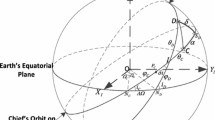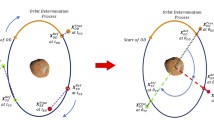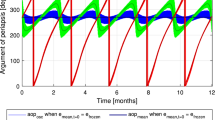Abstract
The determination of the initial conditions for long-term bounded relative motion under natural perturbations is an important theme in satellite cluster flight. Considering the most significant perturbation of the geopotential, namely, the \(\hbox {J}_{2}\) term, many researchers have proposed \(\hbox {J}_{2}\)-mitigating initial conditions for satellite-bounded relative motion. To improve the existing \(\hbox {J}_{2}\)-invariant conditions, two new methods for finding the correction factor are presented in this paper. In these two methods, Method 1 is obtained by minimizing the possible maximum drift in the along-track relative motion. However, Method 2 is designed by nullifying the rates of change of the bounds of the relative motion. Then the geometric character, such as the self-intersection of the \(\hbox {J}_{2}\)-invariant relative orbits, is discussed. The conditions of 0, 1 and 2 (the possible maximum number) self-intersection points are also derived. Then, using Gauss’s equations of planetary motion, an analytical optimal single-impulsive maneuver is deduced to guarantee the secular bounded relative motion under \(\hbox {J}_{2}\), too. Some numerical simulations are performed to validate the corresponding theoretical predictions. The results demonstrate that the proposed methods enhance performance for achieving the bounded relative motion under \(\hbox {J}_{2}\) effects and can be used for future satellite cluster flight missions.









Similar content being viewed by others
References
Alfriend, K.T., Vadali, S.R., Gurfil, P., How, J.P., Breger, L.S.: Spacecraft Formation Flying: Dynamics, Control and Navigation. Butterworth-Heinemann, Oxford (2010)
Arnold, V.I., Kozlov, V., Neishtadt, A.I.: Mathematical Aspects of Classical and Celestial Mechanics, 3rd edn. Springer, Berlin (2006)
Battin, R.H.: An Introduction to the Mathematics and Methods of Astrodynamics. AIAA Education Series, pp. 158–159 (1999)
Biggs, J.D., Becerra, V.M.: A search for invariant relative satellite motion. In: 4th Workshop on Satellite Constellations and Formation Flying, Sao Jose dos Campos, Brazil, pp. 203–213 (2005)
Breger, L., How, J.P., Alfriend, K.T.: Partial \(\text{ J }_{2}\)-invariant for spacecraft formations [C]. In: AIAA Guidance, Navigation, and Control Conference and Exhibit, AIAA 2006-6585, Keystone, Colorado, August 21–24 (2006)
Brown, O., Eremenko, P.: Fractionated space architectures: a vision for responsive space. In: 4th Responsive Space Conference, Los Angeles, CA, RS4-2006-1002, pp. 1–16 (2006)
Dang, Z., Wang, Z., Zhang, Y.: Modeling and analysis of the bounds of periodic satellite relative motion. J. Guid. Control Dyn. 37(6), 1984–1998 (2014A)
Dang, Z., Wang, Z., Zhang, Y.: An improved initial constraint among differential orbital elements for \({\rm J}_{2}\)-invariant relative orbits. In: 2nd IAA Conference on Dynamics and Control of Space Systems, IAA-AAS-DyCoSS2-05-09, Italy (2014b)
Gim, D.W., Alfriend, K.T.: State transition matrix of relative motion for the perturbed noncircular reference orbit. J. Guid. Control Dyn. 26(6), 956–971 (2003)
Goldberg, D.E.: Genetic Algorithms in Search. Optimization and Machine Learning. Addison Wesley Longman, Reading (1989)
Gurfil, P.: Analysis of \({\rm J}_{2}\)-perturbed motion using mean non-osculating orbital elements. Celest. Mech. Dyn. Astron. 90, 289–306 (2004)
Gurfil, P., Kholshevnikov, K.V.: Manifolds and metrics in the relative spacecraft motion problem. J. Guid. Control Dyn. 29(4), 1004–1010 (2006)
Gurfil, P.: Generalized solutions for relative spacecraft orbits under arbitrary perturbations. Acta Astronaut. 60, 61–78 (2007)
Jiang, F., Li, J., Baoyin, H., Gao, Y.: Study on relative orbit geometry of spacecraft formations in elliptical reference orbits. J. Guid. Control Dyn. 31(1), 123–134 (2008)
Jiang, F., Li, J., Baoyin, H.: Approximate analysis for relative motion of satellite formation flying in elliptical orbits. Celest. Mech. Dyn. Astron. 98, 31–66 (2007)
Kasdin, N.J., Gurfil, P., Kolemen, E.: Canonical modeling of relative spacecraft motion via epicycle orbital elements. Celest. Mech. Dyn. Astron. 92, 337–370 (2005)
Kasdin, N.J., Kolemen, E.: Bounded, periodic relative motion using canonical epicyclic orbital elements. In: Proceedings of AAS/AIAA Space Flight Mechanics Meeting, Copper Mountain, Colorado, AAS, pp. 5-186 (2005)
Koon, W.S., Marsden, J.E.: \({\rm J}_{2}\) dynamics and formation flight. In: AIAA Guidance, Navigation, and Control Conference and Exhibit, Montreal, Canada, AIAA 2001-4090 (2001)
Martinusi, V., Gurfil, P.: Solutions and periodicity of satellite relative motion under even zonal harmonics perturbations. Celest. Mech. Dyn. Astron. 111, 387–414 (2011)
Martinusi, V., Gurfil, P.: Analytical derivation of single-impulsive maneuvers guaranteeing bounded relative motion under \({\rm J}_{2}\). J. Guid. Control Dyn. 37(1), 233–242 (2014)
Renner, G., Ekart, A.: Genetic algorithms in computer aided design. Comput. Aided Des. 35, 709–726 (2003)
Sabatini, M., Izzo, D., Palmerini, G.: Minimum control for spacecraft formations in a \({\rm J}_{2}\) perturbed environment. Celest. Mech. Dyn. Astron. 105, 141–157 (2009)
Schaub, H.: Spacecraft relative orbit description through orbit element differences. In: 14th U.S. National Congress of Theoretical and Applied Mechanics, Blacksburg, Virginia, June 23–28 (2002)
Schaub, H.: Relative orbit geometry through classical orbit element differences. J. Guid. Control Dyn. 27(5), 839–848 (2004)
Schaub, H., Alfriend, K.T.: \({\rm J}_{2}\)-invariant relative orbits for spacecraft formations. In: NASA GSFC Flight Mechanics and Estimation Conference, May (1999)
Schaub, H., Alfriend, K.T.: \({\rm J}_{2}\)-invariant relative orbits for spacecraft formations. Celest. Mech. Dyn. Astron. 79, 77–95 (2001)
Schaub, H., Junkins, J.L.: Analytical Mechanics of Space Systems. Aiaa (2003)
Schaub, H., Junkins, J.L.: Analytical Mechanics of Space Systems, American Institute of Aeronautics and Astronautics, 2nd Revised Edition (2009)
Vallado, D.: Fundamentals of Astrodynamics and Applications. McGraw-Hill, New York City (1997)
Vadali, S.R., Schaub, H., Alfriend, K.T.: Initial conditions and fuel-optimal control for formation flying satellite. In: AIAA GNC Conference, Portland, Oregon, Paper No. AIAA, pp. 99–426 (1999)
Xu, M., Xu, S.: \({\rm J}_{2}\)-invariant relative orbits via differential correction algorithm. Acta Mech. Sin. 23, 585–595 (2007)
Xu, M., Wang, Y., Xu, S.: On the existence of \({\rm J}_{2}\)-invariant relative orbits from the dynamical system point of view. Celest. Mech. Dyn. Astron. 112, 427–444 (2012)
Yan, H., Alfriend, K.T.: Numerical searches and optimal control of \({\rm J}_{2}\) invariant orbits. In: 16th Annual AAS/AIAA Spaceflight Mechanics Meeting, Tampa, AAS, pp. 6–163 (2006)
Acknowledgments
This research was supported by the National Natural Science Foundation of China (11002076) and the Graduate Student Innovation Foundation (B120101) of the National University of Defense Technology. The authors thank the anonymous reviewers and the associate editor for their invaluable advice in reviewing this paper.
Author information
Authors and Affiliations
Corresponding author
Appendix: Orbital elements’ variation under \(\hbox {J}_{2}\) perturbation
Appendix: Orbital elements’ variation under \(\hbox {J}_{2}\) perturbation
The variations of the mean elements under a \(\hbox {J}_{2}\) perturbation are as follows:
Rights and permissions
About this article
Cite this article
Dang, Z., Wang, Z. & Zhang, Y. Improved initialization conditions and single impulsive maneuvers for \(\hbox {J}_{2}\)-invariant relative orbits. Celest Mech Dyn Astr 121, 301–327 (2015). https://doi.org/10.1007/s10569-014-9601-4
Received:
Revised:
Accepted:
Published:
Issue Date:
DOI: https://doi.org/10.1007/s10569-014-9601-4




